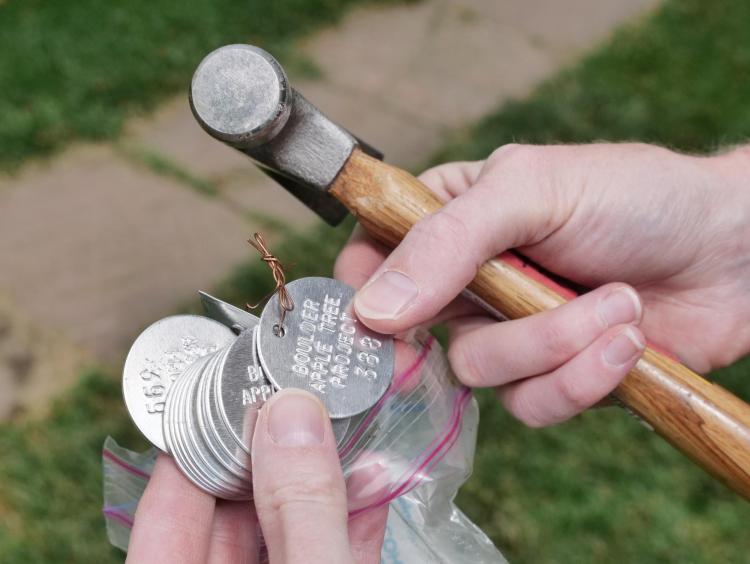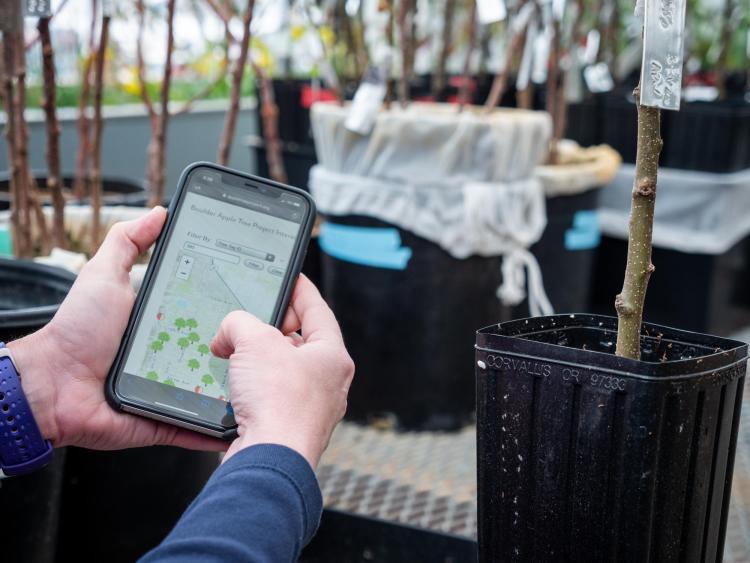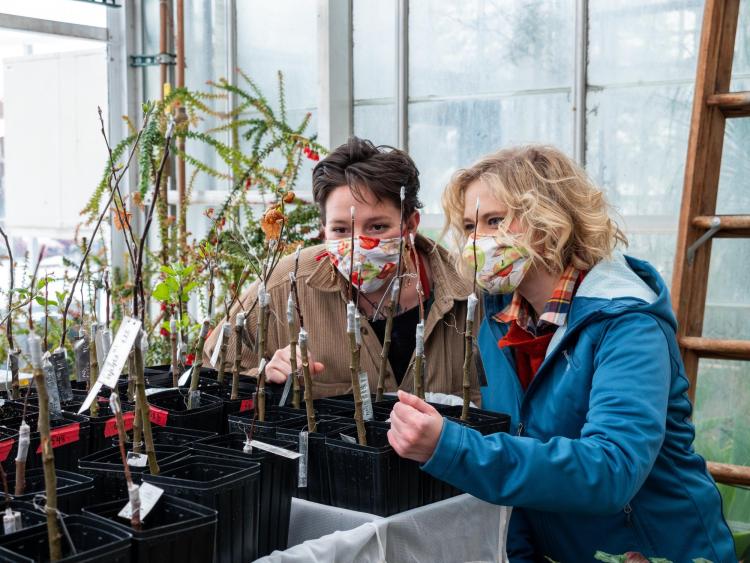Banner image: Amy Dunbar-Wallis of the Boulder Apple Tree Project and two students hold up a grafted apple tree specimen. (Credit: CU Boulder)
Fall means cooler temperatures, changing leaves and apples ready for the picking. This year, there is a bumper crop of ripe Delicious, Ben Davis and yet-to-be-identified fruits in and around Boulder thanks to a wet spring.
For some, it may come as a surprise that apples can flourish along the dry Front Range, but due to the wide variety of genetic diversity in apple trees, some varieties don’t mind the drier climate. In fact, the trees here have a history: In the late 1800s, settlers brought their own seeds from farther east and planted apple trees for subsistence and agriculture. The offspring of those early apple trees are still here—and they need our help.
This weekend, the CU Boulder-based Boulder Apple Tree Project invites the community to help preserve this local apple legacy by locating and collecting data on apple trees in Boulder backyards and on public lands.
“We’re excited to leverage these fantastic old apples across Boulder as educational experiences for our students and to serve the local Boulder community,” said Lisa Corwin, co-investigator of the project and assistant professor in the Department of Ecology and Evolutionary Biology.
Founded in the second half of 2017 by Katherine Suding of the Department of Ecology and Evolutionary Biology, and supported in part by the Office of Outreach and Engagement, the Boulder Apple Tree Project is an educational research endeavor that explores the genetics and history of apple varieties in Boulder and the surrounding area. The goal? To better understand these heirloom trees and how to keep their unique varieties fruiting into the future.
Top: Lisa Corwin measures an apple tree on the CU Boulder campus. Middle: Lisa Corwin and two students shake an apple tree to retrieve samples for data collection. Bottom: Metal tags, which do not harm the trees, are used to tag and identify trees as part of the Boulder Apple Tree Project. (Credit: CU Boulder)
While states like Washington and New York are best known for their apple-centric agriculture, Colorado was once one of the top apple-growing states in the country. This trend declined in the early 1900s as environmental and economic changes proved unfavorable for Colorado orchards, but many of these old trees remain throughout the Boulder area.
However, the life expectancy for an apple tree is at most 100 years. Do the math backwards from 2021, and it becomes clear that there is real urgency to capture the unique biodiversity in these varieties from the early 20th century before they disappear.
“They're beautiful, wonderful pieces of our heritage,” said Corwin. “These trees can also help us understand if different varieties would fare better in Boulder County. Should we be planting specific varieties in future orchards and in people's backyards that might fare better in the dry and cold weather that we have here?”
Better understanding Boulder’s backyard
Amy Dunbar-Wallis, project manager of the Boulder Apple Tree Project and a graduate student in ecology and evolutionary biology, works to connect the community with students on and off campus and use the project’s research to benefit local citizens, the city and county.
This is the project’s fourth year of offering programming and this weekend presents a hands-on opportunity. This Saturday, the project is hosting the 2021 Apple Blitz, which will focus on locating and sampling trees from neighborhoods in Martin Acres and North Boulder.
Teams of undergraduate students, who are studying the apple trees to understand local ecological systems, will partner with community members to survey these neighborhood trees, adding to the 700 local trees already tagged and measured. They’ll measure a tree’s canopy, its trunk, how many apples it’s producing and whether there is any wildlife in the area.
The results will be fed into the project’s interactive, online map of all documented trees. A mobile phone map app, created by CU Boulder computer science students, will debut by the end of the year.
“People can actually see where these different apple trees are, and they can go and explore the ones that are on public land. It’s a really cool piece of living history because we're adding to that historic record of where these trees are, what their health is and so on,” said Dunbar-Wallis. “And we're really excited to continue to work as a community-university partnership.”
After the data collection, participants will be able to share their stories at the CU Museum of Natural History, taste the apples and get exclusive access to the museum's exhibit about apple trees in Boulder. The exhibit is the combined effort of undergraduate research, computer science students, historians, artists and community members, and opens to the public on Monday, Sept. 27.
Fruit of the future
In addition to data collection, the project grafts selected specimens onto healthy apple tree rootstock in the hopes of growing new, robust genetic copies.
And in October, visiting artist Sam Van Aken will plant what will become multi-grafted art trees on campus. Beginning as one variety of apple tree, Van Aken will return over the next three spring semesters to graf up to 20 to 30 different types of apples all onto the same tree.
Not only will these individual trees grow different varieties of apples, but they will flower in different places at different times each spring, according to Corwin.
“You'll have different flower colors, different flower scents, potentially different types of pollinators, different types of bees for whichever variety they're most drawn to. It's going to be really lovely and very visually stimulating,” said Dunbar-Wallis.
The public is welcome to register and attend Van Aken’s talk about The Open Orchard Project at the CU Museum of Natural History on Saturday, Sept. 25 at 1 p.m. This collaboration through the Boulder Museum of Contemporary Art is part of CU Boulder's Art + Science + Action Cohort.
Learn more about the Boulder Apple Tree Project and its history.
"tasty" - Google News
September 22, 2021 at 10:34PM
https://ift.tt/3o3Vfbz
Participate in a historic (and tasty) science project this fall - CU Boulder Today
"tasty" - Google News
https://ift.tt/2VXquX3
https://ift.tt/3c08sJp
Bagikan Berita Ini



















0 Response to "Participate in a historic (and tasty) science project this fall - CU Boulder Today"
Post a Comment